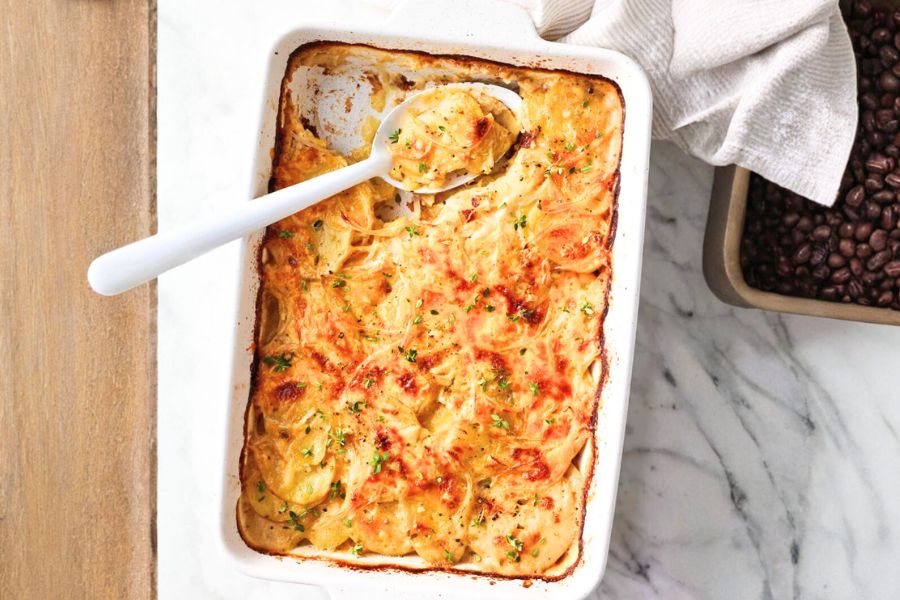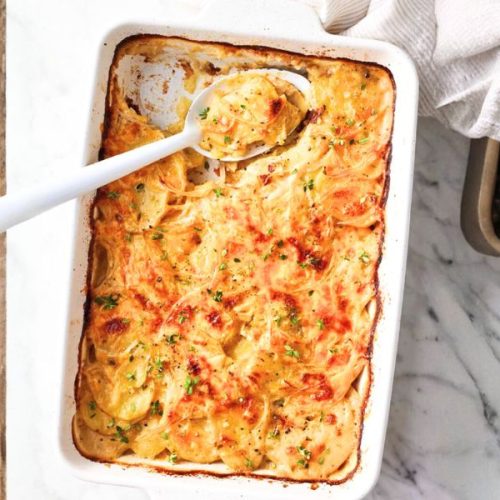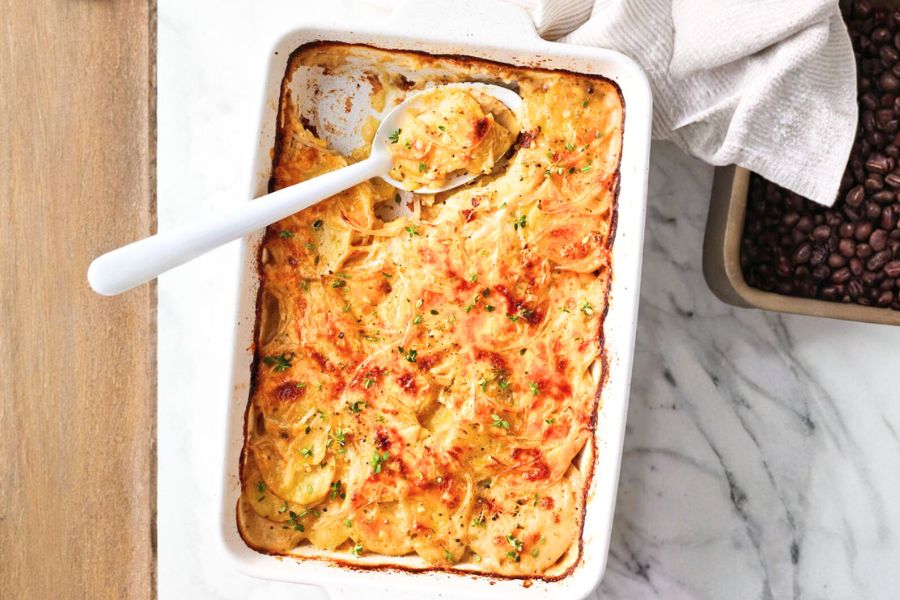This classic scalloped potatoes recipe stands out for its creamy, comforting layers of tender Yukon Gold potatoes, rich cheddar cheese, and a flavorful garlic-thyme sauce.
The use of whole milk and vegetable broth creates a luscious, yet lighter sauce compared to heavier cream-based dishes, making it a more balanced choice.
While not high in protein, the cheese provides a good source of calcium and some protein, while the potatoes offer fiber and important vitamins like vitamin C and potassium.
This recipe is ideal for everyday cooking as it requires straightforward prep, uses accessible ingredients, and yields a crowd-pleasing dish perfect for holidays or family dinners.

Its make-ahead potential and satisfying textures make it excellent for meal prep or potlucks, ensuring you always have a delicious, hearty side on hand.
Must-Have Tools for Perfect Results
9×13-Inch Baking Dish
This pan is essential for layering the potatoes and cheese evenly, allowing heat to distribute perfectly for thorough cooking and golden topping. Its size versatility makes it a kitchen staple for casseroles, roasting, and baking desserts.
Medium Skillet
Perfect for making the creamy roux-based sauce, a quality skillet ensures even heat distribution to avoid scorching and makes whisking smooth sauces easy. This pan is indispensable for sautéing, frying, and more.
Mandoline Slicer
Achieve uniform, ultra-thin potato slices quickly and safely, crucial for even cooking and texture. A mandoline’s precision saves time and effort, making it a must-have for vegetables and fruits prep.
Whisk
Essential for combining flour, milk, and broth into a smooth sauce without lumps. A sturdy whisk also excels in beating eggs, mixing batters, and emulsifying dressings, making it a versatile tool for any home cook.

Flavorful Cheesy Scalloped Potatoes
Equipment
- 1 9×13-inch baking dish
- 1 9×13-inch baking dish
- 1 Mandoline slicer
- 1 Whisk
Ingredients
- 3 tablespoons unsalted butter plus extra for greasing
- ¼ cup all-purpose flour
- 2 cups whole milk
- 1 cup vegetable broth
- 4 cloves garlic finely grated or minced
- 1 tablespoon fresh thyme leaves chopped
- 2 teaspoons sea salt
- ½ teaspoon freshly ground black pepper
- 3 pounds Yukon Gold potatoes peeled and sliced very thin (about 1/8 inch)
- ½ medium yellow onion thinly sliced
- 1½ cups sharp cheddar cheese shredded
Instructions
- Prepare the Baking Dish: Preheat your oven to 400°F (200°C). Generously butter a 9×13-inch casserole dish to prevent sticking and ensure an easy release after baking.
- Make the Creamy Sauce: In a medium saucepan over medium heat, melt the butter completely. Sprinkle in the flour and whisk constantly for about one minute to cook off the raw flour taste, creating a smooth roux. Gradually pour in the milk while continuously whisking to avoid lumps, then stir in the vegetable broth. Add the grated garlic, chopped thyme, salt, and black pepper. Continue cooking and whisking the sauce gently for 2–3 minutes until it thickens enough to coat the back of a spoon. Remove the sauce from the heat.
- Layer the Ingredients: Spread half of the thin potato slices evenly in the bottom of the prepared dish. Add half of the sliced onions on top of the potatoes. Pour half of the creamy sauce evenly over the layer, then sprinkle 1 cup of shredded cheddar cheese over everything. Repeat the process with the remaining potatoes, onions, sauce, and finish with the remaining ½ cup cheese on top.
- Bake Covered and Then Uncovered: Cover the dish tightly with aluminum foil and bake in the preheated oven for 30 minutes. Remove the foil and continue baking for another 35 to 40 minutes. The dish is ready when the potatoes are fork-tender and the cheese on top is bubbly and golden brown.
- Rest Before Serving: Let the scalloped potatoes rest at room temperature for about 20 minutes to allow the sauce to thicken and the flavors to meld before slicing and serving.
Notes
Chef’s Insider Tips for Perfection
Achieving the perfect scalloped potatoes comes down to layering and sauce consistency.
Use a mandoline or a sharp knife to slice your potatoes uniformly thin—about 1/8 inch—so they cook evenly without turning mushy.
When making the sauce, whisk continuously to avoid lumps and cook it just until it thickens enough to coat the back of a spoon.
This creamy base binds the layers and keeps the dish moist and rich.
Don’t rush the resting time after baking; letting it sit for 20 minutes allows the sauce to set, making serving cleaner and enhancing flavors.
For extra depth, add fresh herbs like thyme or rosemary, and feel free to experiment with cheese blends such as Gruyère or mozzarella for unique flavor twists.
Delicious Pairings and Serving Ideas
Scalloped potatoes are a versatile side that pairs beautifully with roasted meats, grilled chicken, or a simple green salad for a lighter option.
For holiday meals, serve alongside glazed ham or roast turkey to complement the creamy, cheesy richness of the dish.
A crisp white wine like Chardonnay or a light-bodied red such as Pinot Noir pairs well with the comforting flavors.
For a vegetarian meal, balance the richness with steamed vegetables or a fresh tomato salad. Garnish with fresh thyme or chopped parsley to add a pop of color and a fresh herbal note that brightens each bite.
Best Storage Practices Explained
To store leftovers, allow the scalloped potatoes to cool completely, then cover tightly with plastic wrap or transfer to an airtight container. Refrigerate for up to 4 days.
When reheating, use a low oven setting (around 325°F/160°C) to gently warm the dish without drying it out, or microwave individual portions covered with a damp paper towel to retain moisture.
This recipe also freezes well: freeze in airtight containers for up to 2 months.
Thaw overnight in the refrigerator before reheating, and add a splash of milk or broth if the sauce seems thickened.
Proper storage maintains the creamy texture and flavor, making for easy make-ahead meals.
Common Questions About Scalloped Potatoes
Q1: Can I use other types of potatoes?
Yes, while Yukon Golds are ideal for their creamy texture and ability to hold shape, Russets or red potatoes can be used. Russets may result in a softer texture, so slice a bit thicker to avoid mushiness.
Q2: Can I prepare this recipe ahead of time?
Absolutely! Assemble the dish a day before baking and keep it covered in the refrigerator. When ready, add extra baking time if baking from cold to ensure potatoes cook through.
Q3: Is there a dairy-free option?
You can substitute the milk with unsweetened plant-based milk like almond or oat milk, and use a vegan butter alternative and dairy-free cheese. The texture will vary slightly but remain delicious.
Q4: How do I prevent the sauce from becoming too thick?
Be careful when cooking the sauce—remove it from heat once it coats the back of a spoon. If it thickens too much after resting, stir in a little more milk or broth to loosen it before layering.
Q5: Can I add other vegetables to this dish?
Yes, thin slices of cooked mushrooms, spinach, or even caramelized onions can be layered in to add flavor and nutrition, but avoid watery vegetables like zucchini unless pre-cooked and drained
This recipe has been adapted and simplified from the original version by loveandlemons. We’ve refined the steps for a smoother cooking experience and added helpful notes, nutrition insights, and essential kitchen tools to make it even easier for home cooks.

